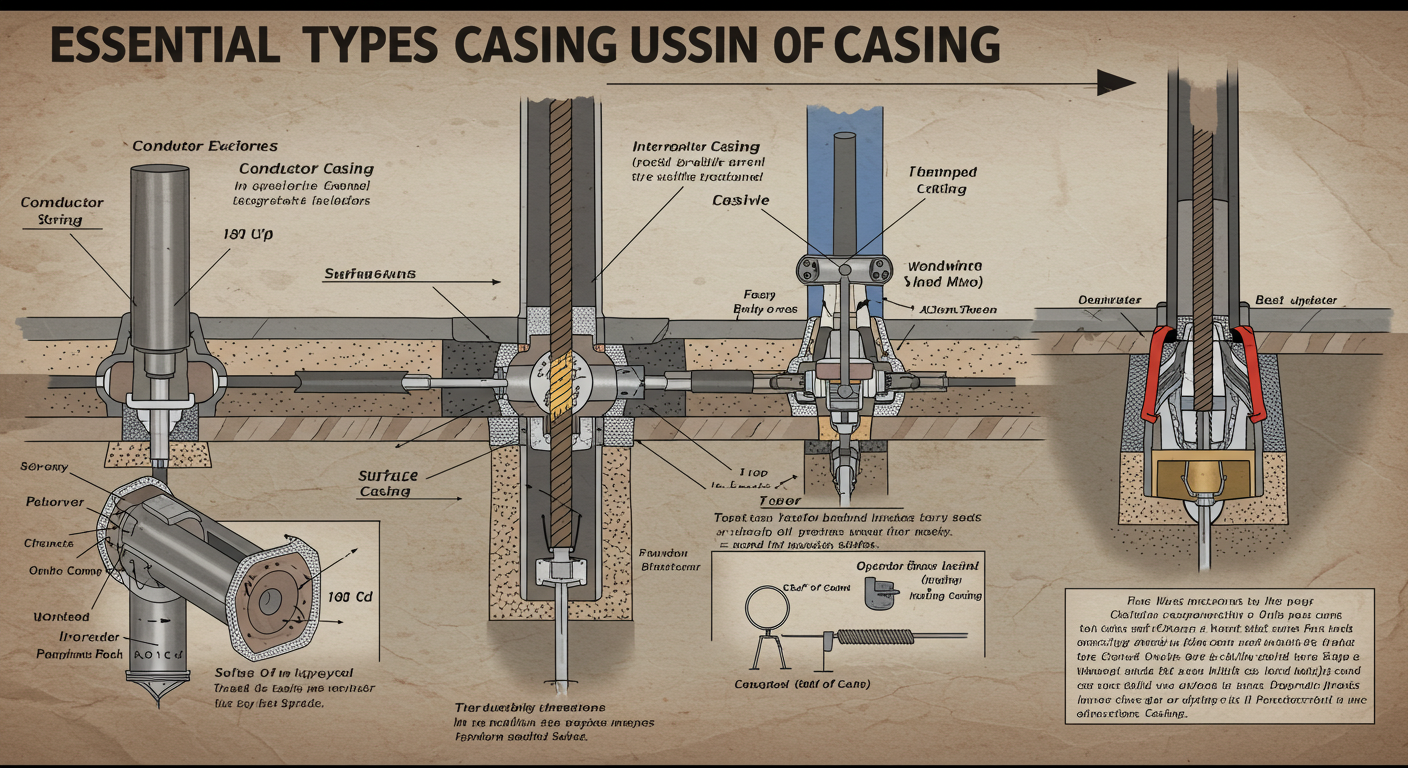Introduction: Why Casing Matters in Oil and Gas Operations
In the complex world of oil and gas extraction, casing and tubing are critical components that ensure both safety and operational efficiency. For industry professionals and stakeholders, understanding these essential elements can mean the difference between a successful drilling operation and costly failures.
Casing serves multiple vital purposes in well construction:
- Provides structural integrity to prevent well collapse
- Isolates different pressure zones within the wellbore
- Protects groundwater from contamination
- Facilitates the controlled extraction of hydrocarbons
This comprehensive guide explores the different types of casing used in oil and gas operations, their specific applications, and the factors that influence their selection and installation.
The 5 Main Types of Casing in Oil and Gas Wells
1. Conductor Casing
Purpose: The first line of defense in well construction
Conductor casing is typically the first type installed in a well. Set at relatively shallow depths (usually 50-200 feet), it provides initial structural support and prevents surface soil and water from contaminating the wellbore.
Key characteristics:
- Largest diameter of all casing types
- Usually installed before the main drilling operations begin
- Acts as a foundation for the entire well structure
2. Surface Casing
Purpose: Protecting freshwater resources
Surface casing extends deeper than conductor casing, typically ranging from 200 feet to several thousand feet depending on local regulations and geological conditions.
Key characteristics:
- Primarily installed to protect freshwater aquifers
- Creates a barrier against hydrocarbon migration
- Serves as a mounting point for blowout prevention equipment
- Diameter is smaller than conductor casing but larger than deeper casings
3. Intermediate Casing
Purpose: Handling challenging formations and providing additional support
When drilling through difficult geological formations or when additional structural integrity is needed, intermediate casing comes into play.
Key characteristics:
- Depth varies based on specific formation challenges
- Isolates different geological formations
- Provides essential structural support in problematic zones
- May be omitted in simpler well designs where conditions permit
4. Production Casing
Purpose: Facilitating controlled hydrocarbon extraction
Production casing is the final full-length casing installed in the well, extending from the productive zone to the surface.
Key characteristics:
- Critical for maintaining long-term well integrity
- Enables safe extraction of oil and gas
- Typically features specialized designs based on reservoir conditions
- Diameter is selected to optimize production flow
5. Liner Casing
Purpose: Targeted reinforcement of specific well sections
Unlike other casing types, liner casing doesn’t extend all the way to the surface. Instead, it’s installed within an existing casing string to provide additional support in specific sections.
Key characteristics:
- More economical than running full-length casing
- Often used in the production zone
- Can be deployed as a quick solution to wellbore problems
- Diameter typically matches or is slightly smaller than the casing it’s set within
Critical Factors in Casing Selection
Choosing the right casing for an oil and gas well involves careful consideration of multiple factors:
Well Depth Considerations
The deeper the well, the more critical casing selection becomes. Different depth ranges typically call for specific casing configurations:
| Depth Range (feet) | Recommended Casing Type |
| 0 – 3,000 | Conductor Casing |
| 3,000 – 8,000 | Surface Casing |
| 8,000 – 12,000 | Intermediate Casing |
| 12,000+ | Production Casing |
Downhole Environmental Conditions
The harsh reality of subsurface conditions significantly impacts casing requirements:
- High Pressure Zones: Require thicker-walled casing to prevent collapse or burst
- Elevated Temperatures: May necessitate specialty alloys to maintain integrity
- Corrosive Environments: Demand corrosion-resistant materials to prevent premature failure
Regulatory Compliance Requirements
Casing selection must adhere to strict industry regulations that govern:
- Safety standards for wellbore protection
- Environmental requirements to prevent contamination
- Specific depth and size requirements based on well classification
Casing Materials: Balancing Strength, Durability and Cost
Standard Steel Casing
The workhorse of the industry, steel casing offers exceptional strength-to-cost ratio:
Characteristics:
- Density: 7.85 g/cm³
- Yield Strength: 240-1,200 MPa
- Typical Thickness: 5.5-19 mm
- Applications: Suitable for most well conditions
Corrosion-Resistant Alloys (CRAs)
When facing aggressive environments, CRAs provide superior protection:
Characteristics:
- Density: 8.0 g/cm³
- Yield Strength: 300-1,500 MPa
- Typical Thickness: 6-12 mm
- Applications: Offshore wells, sour gas environments, high H₂S presence
Composite Materials
Newer to the industry, composites offer unique advantages in specific applications:
Characteristics:
- Density: 1.5-2.5 g/cm³
- Tensile Strength: 250-600 MPa
- Typical Thickness: 4-10 mm
- Applications: Weight-sensitive operations, highly corrosive environments
Essential Casing Design Elements
Diameter and Wall Thickness Selection
These fundamental specifications determine the casing’s performance envelope:
| Casing Diameter (inches) | Typical Wall Thickness (inches) | Common Applications |
| 8.625 | 0.322 | Surface Casing |
| 9.625 | 0.365 | Intermediate Casing |
| 7.625 | 0.322 | Production Casing |
| 5.5 | 0.204 | Liner Casing |
Connection Technologies
How casing sections join together is critical to system integrity:
- Threaded Connections: Offer quick assembly and reliable performance
- Welded Connections: Provide maximum strength in critical applications
- Mechanical Connections: Allow flexibility in specialized situations
Cementing Techniques
The bond between casing and formation depends on proper cementing:
- Primary Cementing: Creates the initial seal between casing and wellbore
- Squeeze Cementing: Addresses leaks and enhances isolation
- Cement Bond Logging: Verifies cementing quality for long-term integrity
The Casing Installation Process: Critical Steps for Success
Running and Cementing Best Practices
The installation process follows a carefully orchestrated sequence:
- Casing Running: Lowering casing sections into the wellbore with specialized equipment
- Centralization: Ensuring casing is properly positioned within the wellbore
- Cementing: Pumping cement into the annular space to secure and seal the casing
Rigorous Testing Protocols
Post-installation testing verifies casing integrity:
- Pressure Testing: Confirms the casing can withstand operational pressures
- Leak-Off Testing: Determines formation pressure limitations
- Cement Bond Testing: Verifies the quality of cement adhesion
Maintaining Casing Integrity Over Time
Inspection Strategies
Regular evaluation prevents costly failures:
| Inspection Type | Purpose | Recommended Frequency |
| Visual Inspection | Detect surface damage | Monthly |
| Pressure Testing | Assess integrity under stress | Quarterly |
| Ultrasonic Testing | Measure wall thickness | Annually |
| Magnetic Particle Inspection | Identify discontinuities | Biannually |
Repair and Maintenance Approaches
When issues arise, timely intervention is essential:
- Casing Patching: Addresses minor leaks and defects
- Section Replacement: Resolves major structural failures
- Grouting: Reinforces compromised cement bonds
Conclusion: The Critical Role of Proper Casing Selection
Selecting the right types of casing in oil and gas operations is fundamental to well success. By understanding the various casing types, their appropriate applications, and the factors influencing their selection, operators can ensure safer, more efficient, and more productive drilling operations.
From conductor casing that initiates the well structure to production casing that facilitates extraction, each component plays a vital role in the overall well system. With proper selection, installation, and maintenance, casing provides the foundation for successful hydrocarbon recovery while protecting both personnel and the environment.



